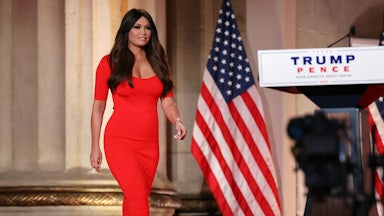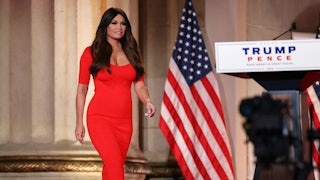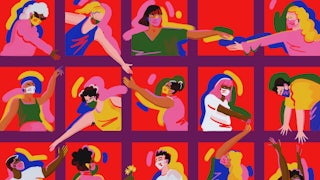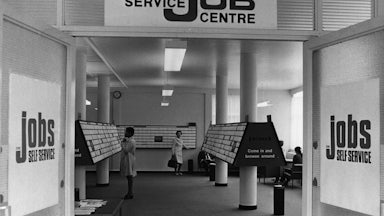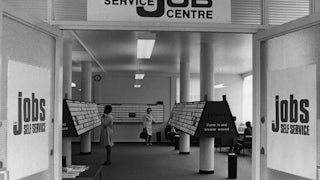The March for Life began in 1974—a year after the Supreme Court decision in Roe v. Wade. It bills itself as the largest social mobilization of any cause in the world. But for the first time in 47 years, anti-choice protesters will not rally en masse in D.C. The march isn’t “canceled,” its organizers announced—it’s going “virtual.”
Just a few weeks ago, organizers were still planning on rallying in person in Washington, D.C., March for Life Defense and Education Fund president Jeanne Mancini said in a January Facebook Live with Students for Life. Their decision could stem from any number of unusual events: Some city- and state-based groups canceled their bus caravans to D.C. due to Covid-19, and the District has restricted permits for large events following recent violence waged by Trump supporters and others on the far right. It’s partially the latter that the March for Life seems most moved by.
“Folks, I know you are seeing some pictures online, but pretty much nothing can describe the war zone that D.C. is right now,” Mancini said in the video. “With an unfriendly administration and with a lot going on right now, even in terms of just the political tensions, we just didn’t think it was safe for our marchers. It’s a tinderbox in D.C. right now.” Mancini said they wanted “to protect our law enforcement, because they’ve been treated so terribly this year.” (“Blue Lives Matter, too,” added Students for Life president Kristan Hawkins. “All lives matter.”)
The supposed threat marchers needed to be kept safe from became a little clearer as Hawkins recounted what it felt like to be in Washington the night, last August, that Trump accepted the Republican nomination for president, when “people … were there, yelling” at attendees as they exited. Mancini had attended herself, she said. “I was so mad that people feel so strongly that they’re not giving us the freedom to believe what we want to believe. Who cares if I supported President Trump?” The role of pro-lifers in this moment, she said, was to help “restore some of these basic freedoms that have been sort of whipped away from us in this scary culture right now.” Hawkins echoed this. “To see the hate in those who were yelling at us … trying to spit at us, it really cemented to me why we need to keep doing what we’re doing in the pro-life movement.”
The post-1973 movement to criminalize abortion has never shied from a culture war. But the one these movement leaders were leaning toward is volatile, willing to do violence. In their maternalism, their professed wishes to protect marchers, the outside threat they see is posed by those standing in the way of Trump. The danger in D.C. they allude to is not one unleashed on the Capitol on January 6 but in the reaction to it, and, seemingly, how they could be targeted themselves. (The Pentagon authorized the presence of the National Guard before the Biden-Harris inauguration, and Pence—not Trump—approved them being called up during the riots.) In any case, the victim role is a familiar one, and they adopted it before Biden had a chance to take any action on abortion. What they are telling the movement here is, Don’t come to Washington because no one here can protect you.
Typically, mainstream anti-choice groups publicly distance themselves from any kind of violence: those who have assassinated abortion providers or bombed clinics. But the fringe of the anti-abortion movement has drawn nearer in recent years. Something kicked into gear when the propaganda videomakers Project Veritas, nearly 10 years ago, claimed Planned Parenthood was a front for child sex trafficking (it is not), evoking the kinds of conspiracy theories that would later power QAnon. Abby Johnson, the anti-choice activist perhaps most known for having left Planned Parenthood for the movement, and who appeared at the 2020 March for Life’s Youth Rally, said she was there at the Capitol, getting “a little bit of pepper spray,” as she later posted. Other pro-Trump forces at the Capitol included John Brockhoeft, convicted of bombing a Planned Parenthood clinic, who was livestreaming himself, as was Operation Rescue assistant director Jason Storms.
Maybe what lines there were between conservatism and far-right extremism have melted away, leaving anti-choice groups a bit adrift. The tension was there in the promotional spots for the nonmarch.
There would still be off-line gatherings this year, Hawkins, the Students for Life president, explained, like a “life chain” (imagine “Hands Across America,” but against abortion) in Arlington, Virginia. There would also be protests (prayers) outside Planned Parenthood clinics in D.C. and 18 other cities. That’s where the real fight is, Hawkins said, and where they had won: state by state, no matter who was in the White House.
But if activists can’t make those gatherings, they can follow along on Facebook, Hawkins announced. “Don’t delete your Facebook account til after the March for Life, please! … even if they censor you!” It was kind of a joke but not a joke: In January, the Students for Life website claimed it could soon be “banned” from social media for being anti-choice—a “purge” that the Susan B. Anthony List has also warned of—and offered instructions on how to find it on Parler and Gab.

